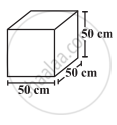Advertisements
Advertisements
प्रश्न
The external dimensions of a closed wooden box are 48 cm, 36 cm, 30 cm. The box is made of 1.5 cm thick wood. How many bricks of size 6 cm × 3 cm × 0.75 cm can be put in this box?
उत्तर
\[\text { The outer dimensions of the closed wooden box are 48 cm } \times 36 cm \times 30 cm . \]
\[\text { Also, the box is made of a 1 . 5 cm thick wood, so the inner dimensions of the box will be } (2\times1.5=3)\text { cm less}.\]
\[\text { i . e . , the inner dimensions of the box are 45 cm } \times 33 cm \times 27 cm\]
\[ \therefore \text { Volume of the box = 45 } \times 33 \times 27 = 40095 {cm}^3 \]
\[\text { Also, the dimensions of a brick are 6 cm } \times 3 cm \times 0 . 75 cm . \]
\[\text { Volume of a brick = 6 } \times 3 \times 0 . 75 = 13 . 5 {cm}^3 \]
\[ \therefore\text { The number of bricks that can be put in the box }= \frac{40095}{13 . 5} = 2970\]
APPEARS IN
संबंधित प्रश्न
A cubical box has each edge 10 cm and another cuboidal box is 12.5 cm long, 10 cm wide and 8 cm high.
(i) Which box has the greater lateral surface area and by how much?
(ii) Which box has the smaller total surface area and by how much?
A small indoor greenhouse (herbarium) is made entirely of glass panes (including base) held together with tape. It is 30 cm long, 25 cm wide and 25 cm high. What is the area of the glass?
There are two cuboidal boxes as shown in the adjoining figure. Which box requires the lesser amount of material to make?
 |
 |
| (a) | (b) |
The length , breadth and height of a room are 5 m, 4.5 m and 3 m, respectively. Find the volume of the air it contains.
Find the surface area of a cuboid whose length = 6 dm, breadth = 8 dm, height = 10 dm.
Find the surface area of a cuboid whoselength = 3.2 m, breadth = 30 dm, height = 250 cm.
A cube of edge 6 cm and a cuboid with dimensions 4 cm x x cm x 15 cm are equal in volume. Find:
(i) the value of x.
(ii) the total surface area of the cuboid.
(iii) the total surface area of the cube.
(iv) which of these two has a greater surface and by how much?
The height of a circular cylinder is 20 cm and the diameter of its base is 14 cm. Find:
(i) the volume
(ii) the total surface area.
Two cuboids with equal volumes will always have equal surface areas.
Three cubes each of side 10 cm are joined end to end. Find the surface area of the resultant figure.
